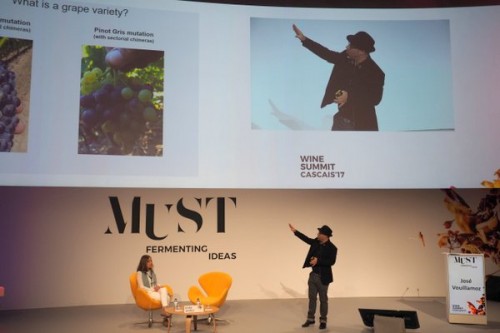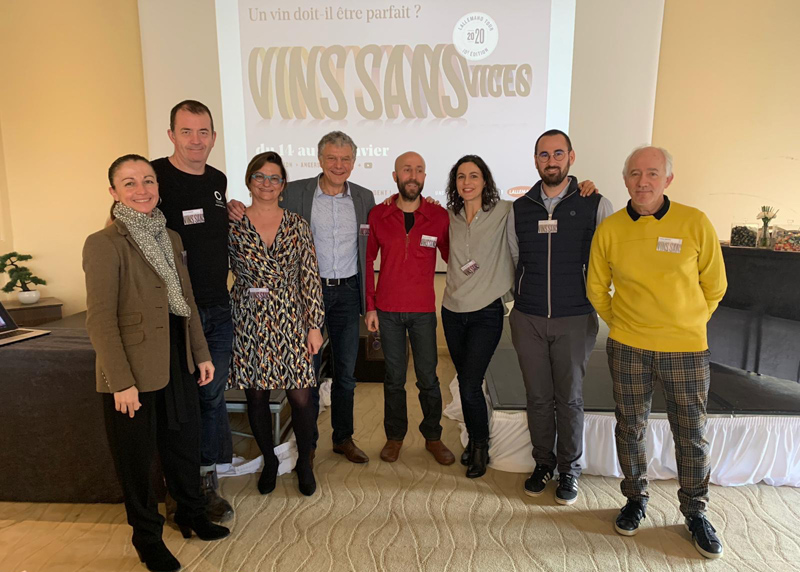
It was great to hear José Vouillamoz present at MUST. He’s a plant scientist with a special interest in grape varieties, and this was the subject of his talk. He began with the news that soon there will be a new edition of Wine Grapes, the reference book he authored together with Julia Harding and Jancis Robinson. This is because since the publication of the first edition, so much more knowledge has come to light.
José posed the important question: what is a grape variety? Each variety starts with a single grape pip that grows into a plant. In the past, when vineyards were planted en foule (not in tidy rows, but each vine individually staked in a random, close-planted arrangement) then it was possible for grape seeds to produce the occasional new vine. First, the seed would need to be eaten by a bird (a passage through a bird’s gut enhances its chance of germinating), then it would need to fall somewhere in the vineyard, and it would have to be allowed to grow and not be cleared out. The wine grower then has to notice the new variety and propagate it through cuttings or layering (both methods are 3-4000 years old).
This propogation is called cloning. The vines are genetically identice. But each time the plant grows you have cell division and the process of multiplication can cause mutations. Most of these are accidents in the DNA and have no visual effect, but some might have spectacular effects such as changing cluster size or colour. These mutations don’t result in new varieties (a new variety can only come from a seed), but new clones. The definition of ‘clone’ is subjective: it’s just when a wine grower decides that a particular vine has desirable features and chooses to clone from it. The more ancient a variety, the more diverse it is in clones. So the fact that there are lots of Pinot Noir clones doesn’t mean that Pinot is genetically unstable, just that it is an old variety.
To have a new variety, you need a father and a mother: every grape variety has parents. It seems simple but it isn’t always. Pinot Noir, Gris and Blanc are all the same variety that has undergone colour mutations. Pinot Noir is the original, and has mutated to become Gris and Blanc. For example, you sometimes see Pinot Noir clusters on one branch and Pinot Blanc clusters on another branch of the same vine. Savagnin, also known as Traminer, is very similar in this regard. There’s Traminer Blanc, Traminer Rot (Savagnin Rose) and Gewürztraminer (Savagnin Rose Aromatique).
Not everyone agrees with this. ‘I’m struggling with colleagues to show them that I am right and they are wrong,’ jokes José, but his definition is the sensible one, although it’s hard for us not to think of the three Pinots as different varieties. He showed that you get similar mutations in Tempranillo and Cabernet Sauvignon, and presumably other red grapes,
José is frustrated by some Italian professors who talk about ‘polyclonal’ varieties, such as Sangiovese. ‘You can’t have one variety coming from different seeds. There are no polyclonal varieties. If you multiply any grape by seeds you get a different variety. Most of the time this is the result of self-fertilization, and it produces a different variety,’ he explains. In Italy in some vineyards they have Sangiovese grown from seed and call it Sangiovese. It’s not: it’s a different variety.
José has done lots of work with DNA analysis to construct family trees of related varieties. He’s found that contrary to what was expected, there are relatively few origins of many of the varieties we know. He came up the concept of founder varieties such as Gouais Blanc, Savagnin and Pinot, each of which gave rise to many different varieties, and has identified 13 of these founders in western Europe. He’s also found them in Georgia and Greece.
Kym Andersen has compiled a list of the world’s Top 35 varieties, and the top 10 come from just 3 countries: Spain, France and Italy. José thinks it is odd that the world is relying on the ampelographic heritage of three countries.
One of his interests is in identifying the missing links: obscure varieties that have almost been forgotten. In the 19th century the diseases powdery and downy mildew, plus phylloxera created a viticultural bottleneck. While there is no evidence that varieties were lost, lots of varieties were forgotten as widescale replanting with grafted vines took place. Many times, people would just choose the easiest varieties,
He then went on to describe some of the obscure varieties that actually played important roles in the viticultural family tree. Chardonnay is a natural crossing of Pinot and Gouais blanc. Gouais Blanc is an important founder variety that was actually banned a number of times (it has very high acidity), yet it is the parent of Chardonnay.
Merlot is a cross between Cabernet Franc and a rare variety called Magdaleine Noire des Charentes. There are just five old vines of Magdaleine left in France. For a long time its role as a parent of Merlot was unknown.
What about Sangiovese? Its parentage was a mystery for a long time. People thought it was either a child of Ciliegiolo or a parent of Ciliegiolo. José found that Ciliegiolo was actually one of its parents, and then went looking for the other one. It turns out to be Calabrese de Montenuova, an obscure variety that was rescued in the gulf of Naples from the bank of Lago d’Averno. So for the Tuscans, it was a big shock to find out that their beloved Sangiovese was half Calabrian.
Tribidrag, also known as Zinfandel, was introduced to California in the 1820s. It is not American in origin, and its real identity was revealed through work by Carole Meredith and coleagues, who carried out what has been dubbed the ‘Zinquest’. They knew that Primitivo was the same variety, but that its origins weren’t Italian. Eventually they found out that its origin is in Croatia. In 2001 they found a grape called Crljenak Kastelanski, which was identical to Tribidrag.
Carmenere from Bordeaux was confused with Merlot in Chile until 1994. When this was discovered, the Chileans decided to keep it, and are now proud to be the country where this grape has survived. It turns out that it’s the same variety as the Chinese Cabernet Gernischt.
There were just 27 hectares left in France but there are 7000 ha in chile and more than 1000 in China.
Cot is a grape from Cahors, known also as Noir de Pressac or Malbeck (which was the name of doctor who propagated it). It was introduced into argentina in 1868 and they forgot the ‘k’, making it Malbec. There are 1000 hectares in France, but 26 000 in Argentina.
José finished by making his guess as to which varieties will be the new stars of the future, but which are currently obscure. He says that this is largely wishful thinking.
Italy has 377 varieties commercially to make wine.
- Timorasso 20 ha currently – Piemonte white variety very aromatic, not easy to grow but many producers replanting this. The new star.
- Mammolo 147 ha – Tuscany – grown in Corsica too. Much fruit, soft tannins
- Nieddera 60 ha – Sardinia – has structure and nice body and has been rescued by Contini
- Teroldego 839 ha – Trentino – lots of colour and fruit, very alpine. Fresh with bitterness. Grows pergola or gobelet. See Foradori for good examples.
France
- Douce Noir 2 ha – Savoie. Used to be the most widespread variety in the region. In Argentina they have more than 18 600 ha of this, which they call Bonarda.
- Counoise 443 ha – South of France, and one of the permitted varieties in Chateauneuf – brings spices – soft and aromatic
- Tibouren 445 ha- Provence, mostly rose wines but excellent reds, such as Clos Sibon. Wines with personality, structure and fruity aromas.
Spain
- Graciano 1468 ha – ‘I’d like to see more of this,’ says José. ‘I love these wines in Sardinia.’ Tinta Miuda in Portugal
- Garro 2 ha – part of the Torres rescue program in Catalonia. Very promising.
- Gorgollasa 4 ha Majorca
Portugal
- Alvarelhao 67 ha – from the Minho
- Rabigato 2452 ha – Douro
- Alfrocheiro 1492 – Dão, Lisboa
- Jampal 106 ha – Lisboa
Greece
- Limniona 10 ha
- Chidiriotiko 60 ha – the pinot of Greece from lesbos
- Kydonista 10 ha
Switzerland has 39 varieties and 15 000 hectares
- Arvine 173 ha
- Rouge du Pays/Cornalin 135 ha
Croatia
- Lasina 10 ha – light red with soft tannins
- Svrdlovina Crna 1 ha just one producer, everyone amazed by this wine at a recent conference
Hungary
- Ezerjo (1665 ha)
- Fekete Jardovany (2 ha)
Georgia
Claims to have 525 varieties but José says they aren’t all different
- Kisi – 50 ha
- Shavkapito – 10 ha
Turkey
- Emir 92 ha – light-bodied white
- Bogazkere
Austria
- Sankt Laurent 795 ha – a child of Pinot
- Zierfandlen
Armenia
- Voskeat – white
- Areni – ‘for me one of the best varieties of the world, Armenia’s Nebbiolo’
1 Comment on José Vouillamoz on grape varieties, at MUST 2017


Curious. You reference arvine in Switzerland and at 173 hectares I know you must be referring to petite arvine. José has mentioned in the past he is especially interested in grosse arvine which is different and little seen. I’m wondering if he wasn’t referring to grosse arvine in his presentation. Just asking.